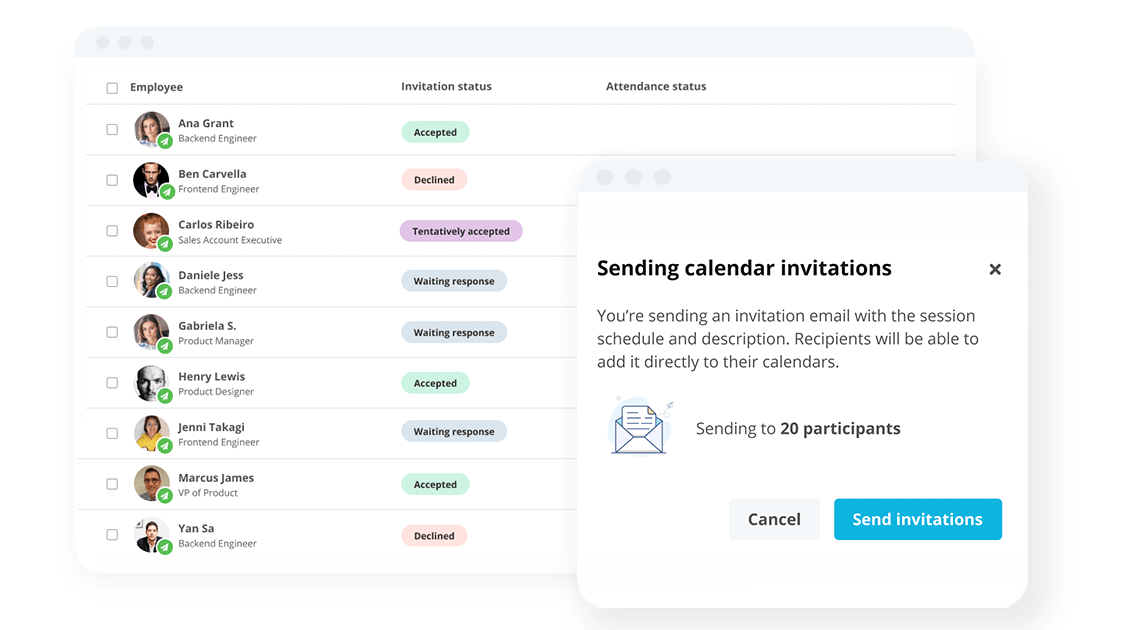
Give the Right Training at the Right Time
Simplify your staff development with centralised training management.
On-the-job training: 7 reasons to embrace it today

On-the-job training: 7 reasons to embrace it today
In this article, we will explore what on-the-job training is and how this hands-on approach used in corporate and HR settings can help manage performance and equip employees with practical skills from day one.
Key Facts
On-the-job training focuses on gaining practical, hands-on experience to learn new skills.
Employees can learn faster and build trust with their peers before they start a new role.
Businesses can benefit from employees who are productive straight out of training.
What is on-the-job training?
On-the-job training is when new employees learn applicable skills for their role in a real work environment. It’s a practical training method, often coordinated using HR software, that uses a hands-on approach in a live or simulated training environment. This typically involves shadowing, peer mentoring, and completing guided tasks supervised by a team lead or manager.
Advantages and disadvantages of on-the-job training
On-the-job training offers several advantages to you and your employees. However, there are also several disadvantages to consider.
Advantages:
It supports fast skill acquisition in a real-world setting
It’s cost-effective compared to classroom training
It can be immediately applied to boost productivity
It can help to build confidence and trust among team members
Disadvantages:
It can reduce the productivity of staff carrying out the training
This may result in inconsistent quality if not standardised
Mistakes can affect actual work outcomes
It’s not ideal for roles requiring deep theoretical knowledge
7 benefits of on-the-job training for employees
1. Expand training with real experience
A key benefit of on-the-job training is that it can accelerate the learning of company tools and processes, especially when used to supplement off-the-job training methods or as part of a broader training program or training needs analysis.
Employees pick up essential skills more quickly when given a visual demonstration of their applicability within the workplace and retain information better with hands-on experience.
2. Easily applicable
Training someone on the job is easier to implement and provides more direct results than a collection or scattering of different training methods. Instead, employees can refer back to old training modules or ask a supervisor. Additionally, practical experience under the guidance of a senior employee can help new hires reduce mistakes before going into a live environment.
3. Saves money and time
On-the-job instruction helps mitigate typical onboarding costs such as training rooms, reference material, presenters, and travel. Employees have easy access to all necessary materials while supervisors provide them with expert guidance. And once their training is complete, they can immediately transition into live work.
4. Increases productivity
One advantage of on-the-job training is that it helps employees retain more information while securing hands-on experience with company processes. Recruitment software is often utilised to help them start with the right tools and become productive faster after transitioning into real work situations. Additionally, the adjustment period is shortened by practical experience and easy access to reference material or peer mentoring.
5. Increases employee retention
When employees aren’t clear on their expectations and responsibilities, it can cause stress that affects job performance and retention rates. On-the-job training mitigates that by providing a clear visual breakdown of all relevant aspects of the position.
6. Flexibility
On-the-job training is moulded around an employee’s needs, with the supervisor providing new information when it’s relevant to the lesson. The less rigid instruction means that the supervisor can adjust employee training on the fly to accommodate unforeseen changes or new knowledge. Additionally, it helps keep new hires from learning company details that aren’t relevant to their positions.
7. Promotes teamwork
Completing training within the workplace helps new employees build relationships with their peers before they officially start working. New hires can help each other when facing a difficult problem in training, and this collaborative ethic carries over to real work situations.
3 important benefits of on-the-job training for employees
There are several benefits of on-the-job training for employees that make them more effective in the workplace.
1. Helps retain information
Employees can retain job-related information more reliably after a hands-on demonstration. Showing how certain skills and knowledge apply to real-life situations gives context to each lesson and makes them easier to imitate.
Once employees transition into their roles, the information needed to perform their jobs is fresh in their minds. As a result, they can become productive faster, especially when supported by effective compensation and benefits management that reinforces their value from day one, integrating with automated payroll solutions to reduce admin workload.
2. Helps build connections with peers
On-the-job training allows current or future co-workers to learn new skills together and support each other through challenging concepts. The collaborative learning environment helps build trust between employees and helps develop valuable teamwork skills.
Employees can enter real work situations with an established support network to rely on if they encounter issues.
3. Helps learn new skills faster
On-the-job training also promotes personal and professional development by providing a simulated environment in which to practise new skills. Employees can pursue personal growth with hands-on activities that help them engage with the lesson. As a result, their new knowledge can be applied to their job responsibilities as soon as possible.
On-the-job training techniques
This includes a variety of employee training programs involved in on-the-job training to improve its effectiveness:
Job Shadowing – New employees will shadow and observe experienced colleagues at work.
Mentoring – Peer mentoring programs provide one-on-one guidance to encourage growth.
Job Rotation – Employees cycle through different roles in a job rotation program.
Coaching – Employees receive ongoing support with consistent feedback.
Simulation – High-risk scenarios are played out by employees in safe environments.
Examples of on-the-job vs. off-the-job training
Training type | Description | Example |
|---|---|---|
On-the-job training | Hands-on learning during real work activities | Shadowing, mentoring, rotations |
Off-the-job training | Learning away from actual job tasks | Workshops, e-learning, seminars |
Frequently asked questions about on-the-job training
What is on-the-job training?
On-the-job training is a type of training that uses hands-on demonstrations to teach employees new skills and knowledge within the workplace.
What are the advantages of on-the-job training?
Using on-the-job training provides several benefits to the company and employees, such as:
Expansion of training with real experience
Easily accessible
Saves money and time
Increases productivity
Increases employee retainment
Flexibility
Promotes teamwork
What is the most important benefit of on-the-job training for employees?
On-the-job training helps employees learn and perform their jobs in real-life situations while minimising potential issues. As a result, job-related knowledge is learned, retained and applied more reliably.
What is the most important benefit of on-the-job training for organisations?
Organisations benefit from employees adapting to their jobs faster because it means they’re productive from the very beginning. Additionally, on-the-job training programs teach basic knowledge first, meaning new hires can help with simple tasks from the first day.
Implementing on-the-job training in your workplace
On-the-job training is useful, but knowing how it affects each employee’s performance can make it more effective. Personio can help with its performance software and training tracking features that let you stay on top of your employees’ progress. Book your free demo to learn how to manage everything in your organisation from one place.
Disclaimer
We would like to inform you that the contents of our website (including any legal contributions) are for non-binding informational purposes only and does not in any way constitute legal advice. The content of this information cannot and is not intended to replace individual and binding legal advice from e.g. a lawyer that addresses your specific situation. In this respect, all information provided is without guarantee of correctness, completeness and up-to-dateness.

